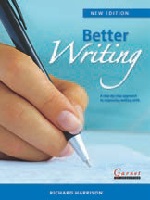A book I've used - Better Writing
Better Writing: A step-by-step approach to improving writing skills (New Edition)
Richard Harrison
Garnet Publishing 2014
 Better Writing is aimed at CEF A2–B1 level (pre-intermediate to intermediate) and teaches writing for a purpose. It is more genre-based than many writing practice books and breaks the skill into bite-sized chunks that link well together. This new fully-revised edition is in full colour and includes a Language review section at the end of each unit.
Better Writing is aimed at CEF A2–B1 level (pre-intermediate to intermediate) and teaches writing for a purpose. It is more genre-based than many writing practice books and breaks the skill into bite-sized chunks that link well together. This new fully-revised edition is in full colour and includes a Language review section at the end of each unit.
There are six units in total, which guide students to write interesting paragraphs on a variety of topics and practise functions such as describing, explaining, reporting and making comparisons. Each unit is divided into three main sections: Focus on the sentence, Focus on the paragraph, and Language review.
The first unit (What’s it like?) covers description: size, colour, material, shape and condition. The second (How things work) practises instructions and has interesting readings on such items as juice extractors and solar ovens. The third (How is it made?) looks at the vocabulary of construction and includes a recipe for hummus and a text on how to make perfume at home. Then two units (Telling a story and Which is better?) that focus on past verb forms, comparatives and superlatives, relative clauses, paragraph organization and style. The final unit (Changes) practises the vocabulary of increase and decrease, as well as verb forms such as the present perfect and the present perfect continuous.
One unit that I used a lot was Telling a story as I spend a lot of time teaching recount. The unit begins with an engaging story. The sentence section begins with five exercises exploring simple past, past continuous and past perfect. Then there is a second story with past tense comprehension questions. The next part is on reporting speech with the student being sent back to the first story to study the reporting verbs. That is followed by activities to find the direct speech in a news article.
Next there is guided work on sentence building, showing the rules for changing reported speech to indirect speech in the past tense and how to join ideas using conjunctions such as After … and Before … The section ends with some punctuation activities.
Paragraphing is the focus of the next section. It begins with a blog about a party and an interesting activity on clause linking, followed by some cloze paragraphs as part of a story and some free writing. The students then work on editing and vocabulary building before doing a crossword puzzle based on words from the unit.
Finally, the Language review section reviews what was learned in the previous sections and there is a motivating cloze exercise of The Life of Pi to review the simple past tense.
Students could use this book for individual work or in class. There is a lot I like about it. I particularly like the approach of going from engaging reading texts to writing. The pages are colourful and nice to look at and each unit has good internal flow and follows a logical sequence. Overall, highly recommended.
Comments
Write a Comment
Comment Submitted